CAA News Today
Propose a Session for the 2014 Annual Conference in Chicago
posted by Lauren Stark — June 26, 2012
 CAA invites individual members to propose a session for the 102nd Annual Conference, taking place February 12–15, 2014, in Chicago, Illinois. Proposals should cover the breadth of current thought and research in visual art, art and architectural history, theory and criticism, pedagogical issues, museum and curatorial practice, conservation, and developments in technology. For full details on the submission process for the conference, please review the information published on the Chair a 2014 Annual Conference Session webpage.
CAA invites individual members to propose a session for the 102nd Annual Conference, taking place February 12–15, 2014, in Chicago, Illinois. Proposals should cover the breadth of current thought and research in visual art, art and architectural history, theory and criticism, pedagogical issues, museum and curatorial practice, conservation, and developments in technology. For full details on the submission process for the conference, please review the information published on the Chair a 2014 Annual Conference Session webpage.
The Annual Conference Committee welcomes session proposals from established artists and scholars, along with those from younger scholars, emerging and midcareer artists, and graduate students. Particularly welcome are proposals that highlight interdisciplinary work. Artists are especially encouraged to propose sessions appropriate to dialogue and information exchange relevant to artists.
The submission process for the 2014 conference is now open. In order to submit a proposal, you must be a current CAA member. Deadline extended: September 14, 2012; no late applications are accepted.
Image: Georges Seurat, A Sunday on La Grande Jatte — 1884, 1884–86, oil on canvas, 81¾ x 121¼ in. Art Institute of Chicago (artwork in the public domain)
Intellectual Property and the Arts
posted by Christopher Howard — June 25, 2012
The Committee on Intellectual Property (CIP) is pleased to announce the posting of the revised and expanded Intellectual Property and the Arts pages on CAA’s website. CIP monitors and interprets copyright legislation for the benefit of CAA’s various constituencies. In so doing, it seeks to offer educational programs and opportunities for discussion and debate in response to copyright legislation affecting educators, scholars, museum professionals, and artists.
The section is divided into the following eight categories: US Copyright: Fundamentals & Documents; Visual Art/Visual Artists; Publishing in the Visual Arts; Libraries, Archives, and Museums; Image Sources and Rights Clearance Agencies; Fair Use Guidelines, Practices, and Policies; Copyright Outside the United States; and Legal Assistance.
Education is essential for informed communication. The committee hopes that the resources presented in the updated pages will answer your questions about intellectual property and inform your discussions and debates.
Solo Exhibitions by Artist Members
posted by CAA — June 22, 2012
See when and where CAA members are exhibiting their art, and view images of their work.
Solo Exhibitions by Artist Members is published every two months: in February, April, June, August, October, and December. To learn more about submitting a listing, please follow the instructions on the main Member News page.
June 2012
Abroad
Gesche Würfel. Underground Gallery, London, United Kingdom, July 26–August 9, 2012. Go for Gold! Photography.
Mid-Atlantic
Serena Bocchino. Simon Gallery, Morristown, New Jersey, May 29–July 31, 2012. Fever. Painting and work on paper.
Midwest
Neil Goodman. Perimeter Gallery, Chicago, Illinois, April 20–May 26, 2012. Breadth. Sculpture.
Northeast
Michele Brody. Guild Gallery II, New York, April 19–June 12, 2012. Drawing Roots. Drawing on handmade paper.
Lisi Raskin. Churner and Churner, New York, February 23–March 31, 2012. Shots in the Dark. Sculpture, drawing, and collage.
Mira Schor. Marvelli Gallery, New York, March 29–April 28, 2012. Mira Schor: Voice and Speech. Painting.
Dee Shapiro. Andre Zarre Gallery, New York, June 19–July 28, 2012. Sexing the Polymorphs. Drawing.
Annie Shaver-Crandell. SiteImages Chelsea, New York, April 19–28, 2012. Steeds, Sofas, and Pistas: The Figure at Home, Abroad, and Afield. Painting.
Margaret Rose Vendryes. Gelabert Studios Gallery, New York, May 29–June 16, 2012. 33⅓ Pushing the Needle: The African Diva Project. Painting and African masks.
South
Patricia Cronin. Newcomb Art Gallery, Tulane University, New Orleans, Louisiana, April 25–June 30, 2012. Patricia Cronin: All Is Not Lost. Watercolor and sculpture.
Patricia Cronin. Arthur Roger Gallery, New Orleans, Louisiana, April 7–June 30, 2012. Patricia Cronin: Memorial to a Marriage. Sculpture.
Ruth Dusseault. Robert C. Williams Paper Museum, Institute of Paper Science and Technology, Georgia Institute of Technology, Atlanta, Georgia, April 20–June 8, 2012. The Innermost Room. Photography and video.
West
Ruth Weisberg. Sylvia White Gallery, North Gallery, Ventura, California, April 11–May 13, 2012. Then and Now. Monotype.
Survey Results on Contingent Faculty in Higher Education
posted by Christopher Howard — June 20, 2012
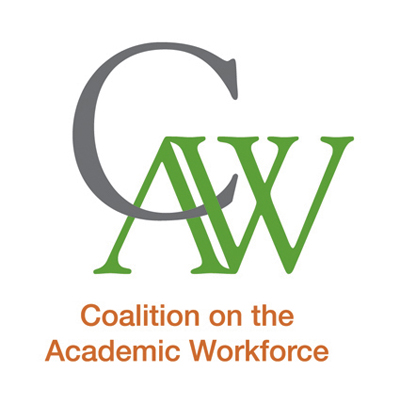 The results of a 2010 survey of contingent faculty members and instructors in American higher education, published today by the Coalition on the Academic Workforce (CAW), have confirmed much of what has been reported anecdotally: part-time faculty members demonstrate a dedicated level of commitment to teaching and to the institutions that employ them, but this commitment is not reciprocated by those institutions through compensation or other professional support. The findings also describe larger course loads for teachers, imbalances in compensation in relation to not only professional credentials but also gender and race, and minimal participation in academic decision-making. Further, contingent faculty face longer durations of provisional employment and slim prospects for career advancement, with schools failing to meet their preference for full-time status.
The results of a 2010 survey of contingent faculty members and instructors in American higher education, published today by the Coalition on the Academic Workforce (CAW), have confirmed much of what has been reported anecdotally: part-time faculty members demonstrate a dedicated level of commitment to teaching and to the institutions that employ them, but this commitment is not reciprocated by those institutions through compensation or other professional support. The findings also describe larger course loads for teachers, imbalances in compensation in relation to not only professional credentials but also gender and race, and minimal participation in academic decision-making. Further, contingent faculty face longer durations of provisional employment and slim prospects for career advancement, with schools failing to meet their preference for full-time status.
According to a 2009 government study, 75.5 percent of all faculty members at colleges and universities in the United States are contingent: that is, they hold part-time or adjunct positions, have full-time non-tenure-track jobs, or serve as graduate-student teaching assistants. Part-timers alone make up nearly half the total professoriate. The US Department of Education, however, has not kept statistics on contingent-faculty salaries since 2003, when it last carried out its National Study of Postsecondary Faculty. CAW’s comprehensive survey, administered in fall 2010, was conducted in an effort to provide meaningful data for this rapidly growing concern. Of the nearly 30,000 survey respondents, 1,102 were CAA members: 591 in studio art and design, 362 in art history, and 149 in art education. The CAW report focuses on the largest group of contingent faculty: part-timers.
CAA is a founding member (1997) of CAW, which is a group of higher-education associations, disciplinary associations, and faculty organizations committed to addressing issues associated with deteriorating faculty working conditions and their effect on college and university students in the United States. Specifically, CAW’s purpose is to: collect and disseminate information on the use and treatment of full- and part-time faculty members serving off the tenure track and the implications for students, parents, other faculty members, and institutions; articulate and clarify differences in the extent and consequences of changes in the faculty within and among the various academic disciplines and fields of study; evaluate the short-term and long-term consequences of changes in the academic workforce for society and the public good; identify and promote strategies for solving the problems created by inappropriate use and exploitation of part-time, adjunct, and similar faculty appointments; promote conditions by which all faculty members, including full- and part-time non-tenure-track faculty members, can strengthen their teaching and scholarship, better serve their students, and advance their professional careers.
Andrew Delbanco, the author of College: What It Was, Is, and Should Be (2012), stated that, in 1975, 60 percent of college professors were full-time faculty with tenure. The reasons for the accelerated shift toward contingent labor since that time are many. Decreases in state funding, capital expansion without commensurate revenue, increases in specialized knowledge requiring thousands of course offerings, and swelling student enrollment all have had a detrimental effect on faculty budgets, more so than on any other area of expenditures in higher education. Jane Wellman, who led the Delta Project on Postsecondary Education Costs, Productivity, and Accountability, affirmed these observations in a recent New York Times interview:
What the evidence shows is that we’ve done more to cut costs in the faculty area than elsewhere in the budget, and we’ve done it by bringing in more adjuncts and part-timers. So there’s a handful of professors with tenure, who don’t teach very much, and then there’s [a] lot of people who have no benefits who do more of the teaching. I think it’s probably hurting academic quality, especially at institutions where the students are not well prepared. The attrition [of students] is mostly in the first two years, and that’s mostly where the adjuncts are.
While no hard evidence has determined that an increase of adjuncts has diminished the quality of teaching in higher education, the CAW survey results clearly demonstrate pressure on part-time faculty due to not only expanding workloads and larger classes—especially for part-time faculty teaching at multiple institutions—but also expectations to be involved in academic decision-making without additional compensation.
Professors of studio art and art history are acutely aware of all these issues. Enrollment has risen persistently for art-history and studio courses for years, while tenured positions have diminished. The survey results do bring some slightly positive news: median pay for contingent faculty in studio art and design and in art history is $3,000 per three-credit course (the nationwide median is approximately $2,700). In addition, workers at campuses with a union presence earn more than those at nonunion schools. Compensation is lower, however, for survey respondents who identified themselves as black, although the number of African Americans who participated in the survey was low. Please visit the CAW website for details on these issues and more.
The CAW report will provide important data for discussions taking place in several of CAA’s Professional Interests, Practices, and Standards Committees. The Student and Emerging Professionals Committee will be addressing contingent-faculty issues at a panel at the 2013 Annual Conference in New York, which will include Michael Bérubé, president of the Modern Language Association and director of the Institute for the Arts and Humanities at Pennsylvania State University, who will present an overview of the Academic Workforce Data Center, a compilation of historical data of the growth of contingent faculty by universities. Bérubé will also discuss the need to nationalize the academic-job market. Jeanne Brody, an adjunct professor at Villanova University and Saint Joseph’s University, will summarize the ways in which adjunct faculty members are effectively organizing and advocating better treatment within the university system. Victoria H. F. Scott of Emory University will discuss the establishment of an Art History Society of the Americas, which would explore abolishing adjunct position types, raising salaries, collecting statistics, and setting policies to improve and monitor working conditions.
The Committee on Women in the Arts, which focuses on women’s issues in the workplace and beyond, will respond to survey results on gender. Although women make up two-thirds of all CAA members, they tend to occupy the lowest rungs of academia, while men continue filling the higher-ranking and higher-paid positions. To continue the discussion, the committee will present a panel at the 2013 conference, chaired by the artist and professor Claudia Sbrissa, on how the “feminization” of art history may have contributed to lower salaries and prestige for women.
Similarly, the Committee on Diversity Practices will discuss issues related to retention of faculty members of color during its panel at the 2013 conference.
CAA would like to thank the individuals who generously volunteered their time and expertise to develop and tabulate CAW’s survey: John Curtis, director of research and public policy, American Association of University Professors; David Laurence, director of research, Modern Language Association; Kathleen Terry-Sharp, director of academic relations and practicing and applied programs, American Anthropological Society; Craig Smith, director of higher education, American Federation of Teachers; and Robert B. Townsend, deputy director, American Historical Association.
Survey Results on Contingent Faculty in Higher Education
posted by Christopher Howard — June 20, 2012
 The results of a 2010 survey of contingent faculty members and instructors in American higher education, published today by the Coalition on the Academic Workforce (CAW), have confirmed much of what has been reported anecdotally: part-time faculty members demonstrate a dedicated level of commitment to teaching and to the institutions that employ them, but this commitment is not reciprocated by those institutions through compensation or other professional support. The findings also describe larger course loads for teachers, imbalances in compensation in relation to not only professional credentials but also gender and race, and minimal participation in academic decision-making. Further, contingent faculty face longer durations of provisional employment and slim prospects for career advancement, with schools failing to meet their preference for full-time status.
The results of a 2010 survey of contingent faculty members and instructors in American higher education, published today by the Coalition on the Academic Workforce (CAW), have confirmed much of what has been reported anecdotally: part-time faculty members demonstrate a dedicated level of commitment to teaching and to the institutions that employ them, but this commitment is not reciprocated by those institutions through compensation or other professional support. The findings also describe larger course loads for teachers, imbalances in compensation in relation to not only professional credentials but also gender and race, and minimal participation in academic decision-making. Further, contingent faculty face longer durations of provisional employment and slim prospects for career advancement, with schools failing to meet their preference for full-time status.
According to a 2009 government study, 75.5 percent of all faculty members at colleges and universities in the United States are contingent: that is, they hold part-time or adjunct positions, have full-time non-tenure-track jobs, or serve as graduate-student teaching assistants. Part-timers alone make up nearly half the total professoriate. The US Department of Education, however, has not kept statistics on contingent-faculty salaries since 2003, when it last carried out its National Study of Postsecondary Faculty. CAW’s comprehensive survey, administered in fall 2010, was conducted in an effort to provide meaningful data for this rapidly growing concern. Of the nearly 30,000 survey respondents, 1,102 were CAA members: 591 in studio art and design, 362 in art history, and 149 in art education. The CAW report focuses on the largest group of contingent faculty: part-timers.
CAA is a founding member (1997) of CAW, which is a group of higher-education associations, disciplinary associations, and faculty organizations committed to addressing issues associated with deteriorating faculty working conditions and their effect on college and university students in the United States. Specifically, CAW’s purpose is to: collect and disseminate information on the use and treatment of full- and part-time faculty members serving off the tenure track and the implications for students, parents, other faculty members, and institutions; articulate and clarify differences in the extent and consequences of changes in the faculty within and among the various academic disciplines and fields of study; evaluate the short-term and long-term consequences of changes in the academic workforce for society and the public good; identify and promote strategies for solving the problems created by inappropriate use and exploitation of part-time, adjunct, and similar faculty appointments; promote conditions by which all faculty members, including full- and part-time non-tenure-track faculty members, can strengthen their teaching and scholarship, better serve their students, and advance their professional careers.
Andrew Delbanco, the author of College: What It Was, Is, and Should Be (2012), stated that, in 1975, 60 percent of college professors were full-time faculty with tenure. The reasons for the accelerated shift toward contingent labor since that time are many. Decreases in state funding, capital expansion without commensurate revenue, increases in specialized knowledge requiring thousands of course offerings, and swelling student enrollment all have had a detrimental effect on faculty budgets, more so than on any other area of expenditures in higher education. Jane Wellman, who led the Delta Project on Postsecondary Education Costs, Productivity, and Accountability, affirmed these observations in a recent New York Times interview:
What the evidence shows is that we’ve done more to cut costs in the faculty area than elsewhere in the budget, and we’ve done it by bringing in more adjuncts and part-timers. So there’s a handful of professors with tenure, who don’t teach very much, and then there’s [a] lot of people who have no benefits who do more of the teaching. I think it’s probably hurting academic quality, especially at institutions where the students are not well prepared. The attrition [of students] is mostly in the first two years, and that’s mostly where the adjuncts are.
While no hard evidence has determined that an increase of adjuncts has diminished the quality of teaching in higher education, the CAW survey results clearly demonstrate pressure on part-time faculty due to not only expanding workloads and larger classes—especially for part-time faculty teaching at multiple institutions—but also expectations to be involved in academic decision-making without additional compensation.
Professors of studio art and art history are acutely aware of all these issues. Enrollment has risen persistently for art-history and studio courses for years, while tenured positions have diminished. The survey results do bring some slightly positive news: median pay for contingent faculty in studio art and design and in art history is $3,000 per three-credit course (the nationwide median is approximately $2,700). In addition, workers at campuses with a union presence earn more than those at nonunion schools. Compensation is lower, however, for survey respondents who identified themselves as black, although the number of African Americans who participated in the survey was low. Please visit the CAW website for details on these issues and more.
The CAW report will provide important data for discussions taking place in several of CAA’s Professional Interests, Practices, and Standards Committees. The Student and Emerging Professionals Committee will be addressing contingent-faculty issues at a panel at the 2013 Annual Conference in New York, which will include Michael Bérubé, president of the Modern Language Association and director of the Institute for the Arts and Humanities at Pennsylvania State University, who will present an overview of the Academic Workforce Data Center, a compilation of historical data of the growth of contingent faculty by universities. Bérubé will also discuss the need to nationalize the academic-job market. Jeanne Brody, an adjunct professor at Villanova University and Saint Joseph’s University, will summarize the ways in which adjunct faculty members are effectively organizing and advocating better treatment within the university system. Victoria H. F. Scott of Emory University will discuss the establishment of an Art History Society of the Americas, which would explore abolishing adjunct position types, raising salaries, collecting statistics, and setting policies to improve and monitor working conditions.
The Committee on Women in the Arts, which focuses on women’s issues in the workplace and beyond, will respond to survey results on gender. Although women make up two-thirds of all CAA members, they tend to occupy the lowest rungs of academia, while men continue filling the higher-ranking and higher-paid positions. To continue the discussion, the committee will present a panel at the 2013 conference, chaired by the artist and professor Claudia Sbrissa, on how the “feminization” of art history may have contributed to lower salaries and prestige for women.
Similarly, the Committee on Diversity Practices will discuss issues related to retention of faculty members of color during its panel at the 2013 conference.
CAA would like to thank the individuals who generously volunteered their time and expertise to develop and tabulate CAW’s survey: John Curtis, director of research and public policy, American Association of University Professors; David Laurence, director of research, Modern Language Association; Kathleen Terry-Sharp, director of academic relations and practicing and applied programs, American Anthropological Society; Craig Smith, director of higher education, American Federation of Teachers; and Robert B. Townsend, deputy director, American Historical Association.
Recent CAA Advocacy
posted by Christopher Howard — June 18, 2012
CAA’s advocacy efforts this year addressed a wide range of issues of critical importance to the visual arts, from the necessity of artists to have affordable health-insurance options, to the ethical treatment of animals in works of art, to the ins and outs of copyright law and museum practices. Below is a summary of eleven issues to which CAA has been committed during the past twelve months.
In June 2011, CAA filed an amicus brief in the case of Golan v. Holder, which the United States Supreme Court began hearing in October. The issue raised in Golan v. Holder is whether Congress, after enacting the Uruguay Round Agreements Act of 1994, could legally remove tens of thousands—if not millions—of foreign works from the public domain and bring them back into copyright. Consistent with the First Amendment, the brief argued that those works should remain freely available. On January 18, 2012, the Supreme Court affirmed a lower court’s previous decision, 6–2. In short, foreign works formerly in the public domain in the US can have their copyrighted status reinstated.
In December 2011, CAA signed onto a statement from the Association of Art Museum Directors that opposed the pending sale of a fifty percent stake in the Alfred Stieglitz Collection of Modern American and European Art at Fisk University in Nashville, Tennessee. Since 2005 the school had been attempting to sell the collection, donated by Georgia O’Keeffe (who specified that it never be sold or broken up). “Such an action,” stated the letter, “would violate a core professional standard of AAMD and of the museum field, which prohibit[s] the use of funds from the sale of works of art for purposes other than building an institution’s collection.” Nevertheless, the Tennessee Supreme court did not block the sale to Crystal Bridges Museum of American Art in Bentonville, Arkansas, on April 25, 2012. The university and museum will share the collection on a three-year rotating basis, with the museum helping to conserve the collection.
CAA board and staff members represented the organization at two events this spring in Washington, DC: Anne Collins Goodyear, then-incoming board president, and Linda Downs, CAA executive director and chief executive officer, attended Humanities Advocacy Day in March; and Judith Thorpe, an outgoing board member, and Helen Bayer, CAA marketing and communications associate, went to Arts Advocacy Day in April. The goal of both days was to support continued federal funding through the National Endowment for the Humanities and the National Endowment for the Arts, and to articulate to Congress the vital importance of the humanities and the arts in higher education. The National Humanities Alliance’s annual meeting coincided with Humanities Advocacy Day. Goodyear and Downs have offered a summary of this important event.
At the request of People for the Ethical Treatment of Animals (PETA), CAA investigated the use of homing pigeons in Jon Rubin’s interactive artwork, Thinking about Flying (2012), on view this year at the Museum of Contemporary Art in Denver, Colorado. The piece invites museum visitors to take home a bird, placed in a cardboard box, for a day before releasing it, so that it may fly back to the museum. CAA confirmed the humanitarian treatment of the birds by the artist and museum and notified PETA of the findings.
In April, CAA investigated the complaint raised by several artists who lent work to the 2010 World Festival of Black Artists and Cultures in Senegal that was not returned due to a dispute with an art shipper in Dakar. CAA determined that the situation did not need the organization’s assistance.
Michael Fahlund, CAA deputy director, testified on behalf of the organization at an oversight hearing convened by New York City’s Committee on Cultural Affairs, Libraries, and International Intergroup Relations on January 25, 2012, regarding increasing access to affordable health insurance for artists. Even though CAA is an international organization, its office is in the state of New York; presently the healthcare industry is regulated state by state. Fahlund proposed that CAA be given “employer status” in relation to its members living in New York State in order to provide health-insurance options for them. The committee’s discussions are ongoing.
CAA monitored a federal bill, the Research Works Act (H.R. 3699), that was introduced in the US House of Representatives on December 16, 2011, by Rep. Darrell Issa (R-CA) and cosponsored by Rep. Carolyn Maloney (D-NY)— chairman and member, respectively, of the House Committee on Oversight and Government Reform. The legislation would prohibit federal agencies from mandating free access to scholarly articles submitted to a scientific or scholarly publication without the consent of the publisher. This act primarily addresses science and technology publications but, if enacted, could affect art and humanities publications as well. Many learned societies who are publishers oppose the legislation, and CAA board members have begun discussing the issue and are paying close attention to the legislation’s development.
Representing CAA, Fahlund contributed his expertise to a National Coalition Against Censorship committee that developed Museum Best Practices for Managing Controversy, published in May. The document offers guidance for institutions to turn controversial situations into learning experiences for their public. The committee comprised representatives from the American Association of Museums, the Association of Art Museum Directors, the Association of Art Museum Curators, Columbia University, Arizona State University, the University of Washington, and the New School. CAA’s Museum Committee is reviewing the guideline and will present it for adoption at the CAA board meeting on October 28, 2012.
Fahlund also worked with a liability insurance broker, Herbert L. Jamison and Co. LLC, and Philadelphia Insurance Companies, and with two CAA members, Barbara Buhler Lynes and Nancy Mowll Mathews, to establish comprehensive, affordable liability insurance for art historians and artists who authenticate works of art. Such insurance would help defend against a damaging financial loss that could occur from alleged mistakes or negligence. CAA does not administer the insurance but acts as a referral to the insurance company; in a brief article from this past January, Fahlund offers helpful loss-prevention tips for the art professional to avoid potential workplace liabilities.
Last month CAA signed onto a letter from the Association of Art Museum Directors sent to Congress, urging legislators to pass the Foreign Cultural Exchange Jurisdictional Immunity Clarification Act (S. 2212), a proposed law that would shield a loaned work of art from a non-US collection from being seized by anyone with a claim to legal ownership while the art is on display in the country. According to the letter, the US has “long provided the crucial legal protection that helps make loans from foreign museums possible” through the Department of State, until a 2004–8 lawsuit involving heirs of Kasimir Malevich and the City of Amsterdam weakened those protections. The House passed the bill (H.R. 4086), which the Senate is now debating.
As a member of the Coalition on the Academic Workforce, a group that addresses workforce issues in higher education, CAA helped to prepare and administer a 2010 survey on contingent-faculty issues. The results have been tabulated and will be distributed soon. More than one thousand CAA members filled out the survey. [June 20 update: the survey results have been published.]
Founded as an advocate for the visual arts in higher education, CAA actively engages matters of public policy, litigation, and activism at the local, state, federal, and international levels. For further information, visit the Advocacy section of the website. If you have questions or have advocacy issues you would like to bring to the attention of the CAA board, please contact Anne Collins Goodyear, CAA president, and Linda Downs, CAA executive director and chief executive officer, at info@collegeart.org.
People in the News
posted by CAA — June 17, 2012
People in the News lists new hires, positions, and promotions in three sections: Academe, Museums and Galleries, and Organizations and Publications.
The section is published every two months: in February, April, June, August, October, and December. To learn more about submitting a listing, please follow the instructions on the main Member News page.
June 2012
Academe
Ellen K. Levy, an artist, writer, and former CAA president, has joined the faculty of the Institute for Doctoral Studies in the Visual Arts in Portland, Maine, as special advisor on art and sciences.
Museums and Galleries
Colette Crossman, administrator of arts and programs for the Jack S. Blanton Museum of Art of the University of Texas at Austin, has been appointed curator of exhibitions at the museum.
Karen Sherry, previously associate curator of American art at the Brooklyn Museum in New York, has been named curator of American art at the Portland Museum of Art in Oregon.
Institutional News
posted by CAA — June 17, 2012
Read about the latest news from institutional members.
Institutional News is published every two months: in February, April, June, August, October, and December. To learn more about submitting a listing, please follow the instructions on the main Member News page.
June 2012
The Art Institute of Chicago in Illinois, on behalf of the School of the Art Institute of Chicago, has been awarded a $40,000 grant from the National Endowment for the Arts to support the Teacher Institute in Contemporary Art at the school, an enrichment program for high school art teachers to engage with the art community of Chicago.
The Baltimore Museum of Art in Maryland has been granted $65,000 from the National Endowment for the Arts to support the reinstallation of its American art collection into newly refurbished galleries, originally designed in 1929 by John Russell Pope.
The Brooklyn Museum in New York has won two bronze 2012 MUSE awards: in the category of Interpretative Interactive Installations for the exhibition Vishnu: Hinduism’s Blue-Skinned Savior; and in the Online Presence category for the website of the exhibition Split Second: Indian Paintings (2011).
California State University, Long Beach, has been awarded Best Show in a University Art Gallery by the United States section of the International Art Critics Association for Perpetual Motion: Michael Goldberg (2010).
Cornell University in Ithaca, New York, is the recipient of a $45,000 grant from the National Endowment for the Arts in support of a program called Objects and Their Makers: New Insights at the Herbert F. Johnson Museum, which aims to introduce students to the arts of Africa, China, Japan, Tibet, and Southeast Asia, and to Precolumbian and Native American art.
The Currier Museum of Art in Manchester, New Hampshire, has been granted a $50,000 award from the National Endowment for the Arts to support the online publication of the museum’s collection of European and contemporary art.
The Dallas Museum of Art in Texas has recently launched a new website application called DMA Dashboard, which offers the public access to real-time museum statistics such as financial data, fundraising, and building operations.
The Getty Conservation Institute in Los Angeles, California, has launched the Conserving Modern Architecture Initiative, an international effort that aims to “increase knowledge for the field and develop new tools to assist practitioners,” according to Tim Whalen, the institute’s director. The initiative’s first project is the long-term conservation of the Eames House in Los Angleles, built by Charles and Ray Eames in 1949.
The J. Paul Getty Museum in Los Angeles, California, has won a 2012 MUSE award, receiving a silver award in the category of Audio Tours and Podcasts for Demons, Angels, and Monsters: The Supernatural in Art (2011). The museum also earned an honorable mention in the category of Applications and APIs for The Life of Art: Context, Collecting, and Display (2012).
The Solomon R. Guggenheim Museum in New York has been awarded the second-place prize for Best Thematic Museum Show in New York by the United States section of the International Art Critics Association for Chaos and Classicism: Art in France, Italy, and Germany, 1918–1936 (2010–11).
The Indianapolis Museum of Art in Indiana has received a $100,000 grant from the National Endowment for the Arts to support the documentation and conservation of the museum’s Western European design collection, a project that is in tandem with moving the collection to a newly designed 9,000-square-foot gallery. The museum has also won a bronze 2012 MUSE award in the category of Public Outreach for its campaign XLVI Reasons to Visit the Indianapolis Museum of Art.
Kennesaw State University in Kennesaw, Georgia, has received a $15,000 grant from the National Endowment for the Arts to aid a multimedia installation by the artist Matt Haffner for display in the lobby of the visual-arts building. A $3 million addition to the Kennesaw State University Art Museum and Galleries was recently approved by the University System of Georgia’s board of regents. The new 9,200-square-foot space, to open in March 2013, will house the university’s art collection and an interdisciplinary research center.
Kent State University in Kent, Ohio, has been awarded a $35,000 grant from the National Endowment for the Arts for an exhibition at the Kent State University Museum, called Shifting Paradigms of Identity: Creative Technology and Fashion, which will address how changing technology affects fashion.
Massachusetts College of Art and Design in Boston has received a $50,000 award from the National Endowment for the Arts to support scholarships for high school juniors and seniors to attend a four-week intensive summer art program.
The Mead Art Museum at Amherst College in Amherst, Massachusetts, has received a $1 million matching endowment grant from the Andrew W. Mellon Foundation in support of an initiative to integrate the museum’s collection into the college curriculum and to endow the position of coordinator of college programs. A stipulation of the grant calls for Amherst to raise a matching $1 million within three years.
The Menil Collection in Houston, Texas, has been awarded the second place in the category of Best Monographic Museum Show Nationally by the United States section of the International Art Critics Association for Kurt Schwitters: Color and Collage (2010–11).
The Metropolitan Museum of Art in New York has been awarded first place in the category of Best Architecture or Design Show by the United States section of the International Art Critics Association for Alexander McQueen: Savage Beauty (2011). The museum also won first place for Best Historical Museum Show Nationally for The Steins Collect: Matisse, Picasso, and the Parisian Avant-Garde (2012).
Michigan State University in East Lansing has been awarded a $40,000 grant from the National Endowment for the Arts to expand the reach of the Michigan Traditional Arts Program. In addition to documenting traditional artists and folk-art events, the program will enhance its online resources and use of social media to help connect folk artists, audiences, and other cultural workers.
Mount Mercy University in Cedar Rapids, Iowa, is the recipient of a $30,000 grant from the National Endowment for the Arts to support the conservation and documentation of William Lightner’s Our Mother of Sorrows Grotto, an outdoor environment and shrine made up of semiprecious stones, cement, and mosaics, built between 1929 and 1941.
The Museum of Fine Arts, Boston, in Massachusetts has received $80,000 from the National Endowment for the Arts to support two components of the museum’s Korean Collection Access Initiative—the publication of a catalogue and the reinstallation of the Korean art collection into a new 1,200-square-foot gallery.
The Museum of Modern Art in New York has been awarded first place in the category of Best Thematic Museum Show in New York by the United States section of the International Art Critics Association for On Line: Drawing through the Twentieth Century (2010–11). The museum has also won a gold 2012 MUSE award in the Public Outreach category for its interactive ad campaign “I went to MoMA and….”
The National Council on Education for the Ceramic Arts, based in Erie, Colorado, has accepted a $40,000 grant from the National Endowment for the Arts to assist exhibitions related to its 2013 national conference, to be held in Houston, Texas. An additional exhibition will take place in Santa Fe, New Mexico, to coincide with the forty-fifth general assembly of the International Academy of Ceramics.
The National Palace Museum in Taipei City, Taiwan, has won a gold 2012 MUSE award in the category of Multimedia Installations for the exhibition Along the River, During the Ching-ming Festival (2009).
The National Portrait Gallery of the Smithsonian Institution in Washington, DC, has received a first-place award from the United States section of the International Art Critics Association for the Best Thematic Museum Show Nationally for Hide/Seek: Difference and Desire in American Portraiture (2010–11).
The National Portrait Gallery in London, England, has recorded its highest-ever attendance figure for a single year, with 2 million museum-goers in 2011.
The Nelson-Atkins Museum of Art in Kansas City, Missouri, has received $100,000 from the National Endowment for the Arts for the digitization of its collection of more than 8,400 photographs ranging from 1839 to the present day.
The Neuberger Museum of Art, part of Purchase College, State University of New York, in Purchase, New York, has been awarded second place by the United States section of the International Art Critics Association for Best Thematic Museum Show Nationally for The Deconstructive Impulse: Women Artists Reconfigure the Signs of Power, 1973–1999 (2011).
Pacific Northwest College of Art in Portland, Oregon, has received a $30,000 grant from the Collins Foundation in support of an initiative called Persist and Thrive, which seeks to diversify the student body and provide mentoring services and academic support for students from underrepresented backgrounds.
The Philadelphia Museum of Art in Pennsylvania has received a 2012 Philadelphia Exhibitions Initiative Grant from the Pew Center for Arts and Heritage. The museum will use the $250,000 grant to fund an exhibition for fall 2013, called Dancing around the Bride, devoted to Marcel Duchamp and his influence on John Cage, Merce Cunningham, Jasper Johns, and Robert Rauschenberg.
Pratt Institute in Brooklyn, New York, has earned a $30,000 grant from the National Endowment for the Arts to aid the school’s community outreach program, Design Initiative for Community Empowerment. The program provides a platform for underserved Brooklyn high school students to learn about design through guided studio work, public exhibitions, and studio visits.
The San Diego Museum of Art in California has received a $15,000 grant from the National Endowment for the Arts to support an artist’s residency for teenagers from the culturally diverse neighborhood of southeast San Diego. The residency will consist of visits to local art museums and also provide studio space and instruction from professional artists.
The San Francisco Museum of Modern Art in California has received a $375,000 grant from the Getty Foundation to support the Robert Rauschenberg Research Project, an online catalogue scheduled for completion in 2013 that will feature all the artist’s works held in the museum’s permanent collection. The project is part of a larger initiative to digitize museum catalogues, spearheaded by the Getty Foundation, called the Online Scholarly Catalogue Initiative.
The School of the Art Institute of Chicago in Illinois has received an award from the United States section of the International Art Critics Association for Best Show Involving Digital Media, Video, Film, or Performance for Yael Bartana: A Declaration, held at the Gene Siskel Film Center on March 10, 2011.
Scripps College in Claremont, California, has won a grant of $10,000 from the National Endowment for the Arts to support the offsite conservation of seven Chinese textiles from the sixteenth and seventeenth century in its Ruth Chandler Williamson Gallery.
Syracuse University Library in Syracuse, New York, has received more than 1,350 digitized documents, letters, and images from the Archives of American Art for its recently launched Marcel Breuer Digital Archive.
UB Anderson Gallery at the University of Buffalo in New York has been declared a 2012 MUSE award winner, receiving a silver Honeysett and Din Student Award for the touch-based website component of a permanent installation, Cravens World: The Human Aesthetic.
The Edwin A. Ulrich Museum of Art at Wichita State University in Wichita, Kansas, has been awarded $100,000 from the National Endowment for the Arts to restore a 1978 mural by Joan Miró that decorates the museum’s façade.
The University of the Arts in Philadelphia, Pennsylvania, has won a $15,000 grant from the National Endowment for the Arts to support a juried design/building competition called Something from Nothing: Eco-ventions for Urban Landscapes. The competition seeks proposals that reimagine derelict and underused urban spaces.
The University of Massachusetts in Amherst has earned $100,000 from the National Endowment for the Arts to support an exhibition and related programming devoted to the legacy of W. E. B. DuBois at the University Museum of Contemporary Art. The exhibition commemorates the 150th anniversary of the Emancipation Proclamation and will examine DuBois’s influence on social and political movements throughout the twentieth century.
The University of Michigan at Ann Arbor has received a $55,000 grant from the National Endowment for the Arts to update the University of Michigan Museum of Art with multimedia tools that will enhance visitors’ experience of the collection.
The University of Oregon in Eugene has been awarded a $40,000 grant from the National Endowment for the Arts to support an apprenticeship program called Preserving and Sustaining Oregon’s Cultural Traditions, which connects master folk artists to apprentices.
The University of Rochester in Rochester, New York has been granted $15,000 from the National Endowment for the Arts. The school will use the funds to conserve paintings and drawings by Carl W. Peter in the collection of the Memorial Art Gallery.
The University of South Florida in Tampa has been awarded a $75,000 grant from the National Endowment for the Arts to support the development of a traveling exhibition, UnCommon Practice: Graphicstudio, organized in partnership with the Tampa Museum of Art and the University of South Florida Contemporary Art Museum. The exhibition documents the forty-five-year history of the Graphicstudio at the university.
The Walker Art Center in Minneapolis, Minnesota, has received a gold 2012 MUSE award in the category of Online Presence for its new website, launched in late 2011.
The Walters Art Museum in Baltimore, Maryland, has won a grant from the National Endowment for the Humanities for $265,000 to support the digitization of 113 medieval Flemish manuscripts, including eighty Books of Hours prayer books. Since 2008, the museum has received two other grants for the purpose of digitizing their manuscript collection.
The Whitney Museum of American Art in New York has received $1.5 million from the Henry Luce Foundation. The grant will assist the museum’s relocation in 2015 to a new Renzo Piano–designed building in Manhattan’s Meatpacking District. The funds will also go toward the Whitney’s Collections Documentation Initiative, an effort to further document its permanent collection before the move. The United States section of the International Art Critics Association has awarded a first-place prize for the Best Monographic Museum Show in New York to the Whitney for Paul Thek: Diver (2010–11), and second-place prize for Glenn Ligon: AMERICA (2011). Last, the Whitney has won a silver 2012 MUSE award in the category of Education and Outreach for its interactive website, For Kids, and a bronze 2012 MUSE award for Video, Film, and Computer Animation for the Vlog Project, comprising short videos that feature deaf museum educators discussing contemporary art in American Sign Language.
Winterthur Museum, Garden, and Library in Winterthur, Delaware, has received a $50,000 award from the National Endowment for the Arts to support a digitization project that will document 4,000 works on paper, including eighteenth-century maps, watercolors, drawings, and silhouettes.
The Worcester Art Museum in Worcester, Massachusetts, has been awarded $20,000 from the National Endowment for the Arts to aid a project called Teen Artists @ WAM, in which students take classes with artist mentors and compete to make large-scale installations with the assistance of professional artists.
Senate Committee Approves IMLS Funding; Congress Needs to Hear from You
posted by CAA — June 15, 2012
The American Association of Museums (AAM) sent the following email on June 15, 2012.
Senate Committee Approves IMLS Funding; Congress Needs to Hear from You
This week, the Senate Appropriations Committee approved a bill to fund the Institute of Museum and Library Services (IMLS). While the bill would sustain the current $30.8 million for the Office of Museum Services for FY13, this is just the first step in the appropriations process.
The bill faces an uncertain future because it includes funding for implementation of the health care reforms enacted in 2010. In a preview of the difficult budgetary decisions to come, Appropriations Committee Ranking Member Richard Shelby said, “In this grave fiscal climate we should not fund programs we know are going to force our country deeper into debt…. We should not mortgage our children’s future for non-essential, unproven programs.”
AAM President Ford W. Bell urged continued advocacy. “At a time when every federal program is being scrutinized, Members of Congress need to hear from constituents about how IMLS funds are essential to museums and how successful they are in serving our communities,” he said. “Participating in ‘Invite Congress to Visit Your Museum Week’ is a great opportunity to demonstrate our value.”
The bill would provide $158.8 billion in discretionary funding, a $2 billion increase over FY12 levels, which is in line with President Obama’s FY13 budget request. The bill also includes $549 million (level funding) for the Race to the Top initiative, President Obama’s signature competitive grant program, which rewards states for making changes in elementary and secondary education.
Let your Members of Congress know how important funding for the Office of Museum Services is to you!
Invite Congress to Visit Your Museum.
Visit www.speakupformuseums.org to learn more about AAM’s Advocacy for Museums.
Grants, Awards, and Honors
posted by CAA — June 15, 2012
CAA recognizes its members for their professional achievements, be it a grant, fellowship, residency, book prize, honorary degree, or related award.
Grants, Awards, and Honors is published every two months: in February, April, June, August, October, and December. To learn more about submitting a listing, please follow the instructions on the main Member News page.
June 2012
Peter Jonathan Bell, a PhD candidate at the Institute of Fine Arts, New York University, has received the Robert Lehman Pre-Doctoral Rome Prize to study at the American Academy in Rome. Bell will be working on a project titled “The Reinvention of the Bronze Statuette in Renaissance Italy: Presentation, Material, Facture.”
Pat Boas, an artist and graduate of Pacific Northwest College of Art in Portland, Oregon, has been awarded the Bonnie Bronson Fellowship from her alma mater. The fellowship includes the purchase of an artwork for permanent installation at Reed College.
Elizabeth Hill Boone, Martha and Donald Robertson Chair in Latin American Art at Tulane University in New Orleans, has been elected a fellow of the American Academy of Arts and Sciences and a corresponding member of the Academia Mexicana de la Historia.
Bradford R. Collins, associate professor of art history at the University of South Carolina in Columbia, has been listed in the Princeton Review’s 2012 publication The Best 300 Professors.
Sophie Cras, a doctoral candidate at the Université Paris 1 Panthéon-Sorbonne, has been awarded the 2012 Terra Foundation for American Art International Essay Prize for her essay “Art as Investment and ‘Artistic Shareholding’ Experiments in the 1960s,” an examination of how a group of American conceptual artists made money and financial transactions the subject of their work.
Diana H. DePardo-Minsky, assistant professor of art history at Bard College in Annandale-on-Hudson, New York, and a specialist in Italian Renaissance and ancient Roman art and architecture, has been recognized in the Princeton Review’s publication The Best 300 Professors (2012).
Charles Fairbanks, a filmmaker from Eustis, Nebraska, has earned a 2012 fellowship from the John Simon Guggenheim Memorial Foundation. In his recent work Fairbanks documents his involvement with Lucha Libre wrestling in Mexico. He is also collaborating with an indigenous Zoque community in Chiapas, Mexico, on a new film.
Margot Fassler, professor of theology and music at the University of Notre Dame in Indiana, has been named an American Council of Leaned Societies 2012 Digital Innovation Fellow. Fassler’s project proposal is to create a digitized, sounding model of Hildegard of Bingen conception of the cosmos, utilizing the advanced technology of Notre Dame’s Digital Visualization Theater.
Leonard Folgarait, professor of history of art at Vanderbilt University in Nashville, Tennessee, and a scholar of modern art of Latin America, Mexico, Europe, and America, has been listed in the Princeton Review’s The Best 300 Professors (2012).
Seth Adam Hindin, a historian of medieval art and architecture, has been appointed American Council of Leaned Societies New Faculty Fellow at the University of California, Davis.
Stanya Kahn, a video artist from Los Angeles, California, and an adjunct faculty member in the Department of Intermedia at the University of Southern California, has won a 2012 John Simon Guggenheim Memorial Foundation Fellowship.
Dana Leibsohn, professor of art at Smith College in Northampton, Massachusetts, and Carolyn Dean, professor and associate dean of the arts division at the University of California, Santa Cruz, have been jointly awarded an American Council of Leaned Societies Collaborative Research Fellowship in support of their book project on colonial Spanish America and the art and objects of its indigenous people.
Brenda Longfellow, associate professor of art and art history at the University of Iowa in Iowa City, has been awarded an Andrew Heiskell Post-Doctoral Rome Prize from the American Academy in Rome. Longfellow intends to work on a project called “Past Lives, Present Meanings: Reused Statues in Imperial Rome.”
Camille S. Mathieu, a PhD candidate in art history at the University of California, Berkeley, has been granted a second year at the American Academy in Rome via the Donald and Maria Cox/Samuel H. Kress Foundation Pre-Doctoral Rome Prize. Her project is entitled “Revolutionizing the Antique: French Artists and Artistic Community in Napoleonic Rome, 1803–1819.”
Maurie D. McInnis, professor of American art and material culture at the University of Virginia in Charlottesville, has been awarded the twenty-fourth Charles C. Eldredge Prize for Distinguished Scholarship in American Art for her book, Slaves Waiting for Sale: Abolitionist Art and the American Slave Trade (Chicago: University of Chicago Press, 2011). In conjunction with the award, McInnis will present the Eldredge Prize lecture at the Smithsonian Museum of American Art in Washington, DC, on October 18, 2012.
Kathryn Blair Moore has been appointed an American Council of Leaned Societies New Faculty Fellow in History of Art and Italian Studies at the University of California, Berkeley.
Jennifer W. Reeves, a painter based in Callicoon, New York, has been awarded a 2012 John Simon Guggenheim Memorial Foundation Fellowship.
Conrad Rudolph and Jeantte Kohl, both professors of art history at the University of California, Riverside, and Amit Roy-Chowdhury, a professor in the Department of Electrical Engineering at Riverside, have received a start-up grant from the National Endowment for the Humanities for “FACES: Faces, Art, and Computerized Evaluation Systems,” a project that will test the use of facial-recognition software in the context of art history, with a long-term goal of assisting in the identification of human subjects in portraiture.
Lisa Saltzman, a professor of art history at Bryn Mawr College in Bryn Mawr, Pennsylvania, has received a 2012 John Simon Guggenheim Memorial Foundation Fellowship. Saltzman’s project is entitled “Daguerreotypes: Fugitive Subjects, Contemporary Objects.”
Claudia Sbrissa, a New York–based based artist who works in drawing and collage, has received a residency fellowship from the Constance Saltonstall Art Foundation in Ithaca, New York, for May and June 2012.
Tanya Sheehan, assistant professor of art history at Rutgers University in New Brunswick, New Jersey, has been awarded two fellowships for 2012–13: a research fellowship from the Harry Ransom Center at the University of Texas at Austin; and the Beatrice, Benjamin, and Richard Bader Fellowship in the Visual Arts of the Theatre from Harvard University.
Gesche Würfel, an artist based in New York, has recently been awarded two grants: a Manhattan Community Arts Fund grant from the Lower Manhattan Cultural Council and a Creative Grant from the Northern Manhattan Arts Alliance. Both awards will help her to develop a new photography project, Basement Sanctuaries, which documents how superintendents decorate basements of apartment buildings in upper Manhattan.




 Gesche Würfel, Go for Gold! 2009 The Blue Fence | Olympic Stadium 4, 2007, digital C-type print, 20 x 20 in. (artwork © Gesche Würfel)
Gesche Würfel, Go for Gold! 2009 The Blue Fence | Olympic Stadium 4, 2007, digital C-type print, 20 x 20 in. (artwork © Gesche Würfel)
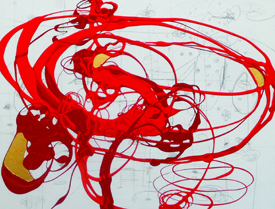 Serena Bocchino, 99º (Fever) Hold Me Tight, 2012, enamel, graphite, and gold leaf on canvas, 38 x 48 in. (artwork © Serena Bocchino)
Serena Bocchino, 99º (Fever) Hold Me Tight, 2012, enamel, graphite, and gold leaf on canvas, 38 x 48 in. (artwork © Serena Bocchino)

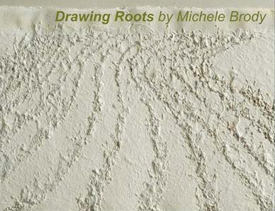

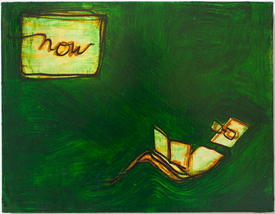 Mira Schor, Now, 2011, ink, oil, and gesso on linen 14 x 18 in. (artwork © Mira Schor)
Mira Schor, Now, 2011, ink, oil, and gesso on linen 14 x 18 in. (artwork © Mira Schor)
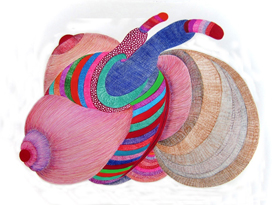 Dee Shapiro, Comfort Zone, 2011, ink and Flashe paint on paper, 22 x 30 in. (artwork © Dee Shapiro)
Dee Shapiro, Comfort Zone, 2011, ink and Flashe paint on paper, 22 x 30 in. (artwork © Dee Shapiro)
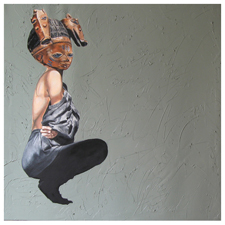 Margaret Rose Vendryes, Gelede Cherrelle – African Diva, 2012, oil and cold wax on canvas with paper, 30 x 30 in. (artwork © Margaret Rose Vendryes)
Margaret Rose Vendryes, Gelede Cherrelle – African Diva, 2012, oil and cold wax on canvas with paper, 30 x 30 in. (artwork © Margaret Rose Vendryes)
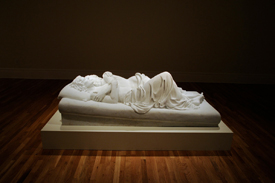 Patricia Cronin, Memorial to a Marriage, 2002, over life-sized Carrara marble (artwork © Patricia Cronin; photograph provided by the artist)
Patricia Cronin, Memorial to a Marriage, 2002, over life-sized Carrara marble (artwork © Patricia Cronin; photograph provided by the artist)
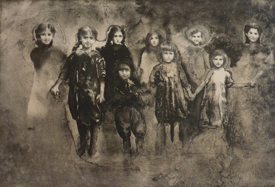 Ruth Weisberg, Together Again, 1975, color lithograph, 15 x 22 in. (artwork © Ruth Weisberg)
Ruth Weisberg, Together Again, 1975, color lithograph, 15 x 22 in. (artwork © Ruth Weisberg)
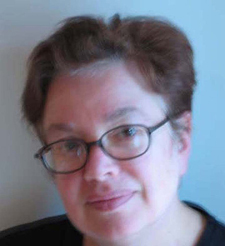 Ellen K. Levy
Ellen K. Levy
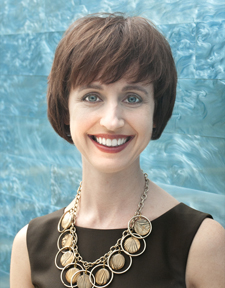 Colette Crossman (photograph by Rick Hall)
Colette Crossman (photograph by Rick Hall)
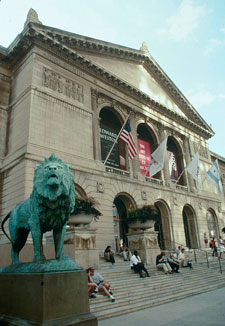 South view of the Michigan Avenue façade of the Art Institute of Chicago (photograph provided by the Art Institute of Chicago)
South view of the Michigan Avenue façade of the Art Institute of Chicago (photograph provided by the Art Institute of Chicago)
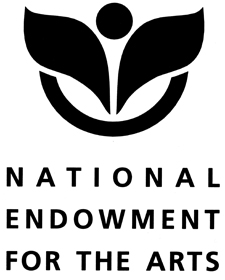

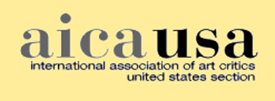

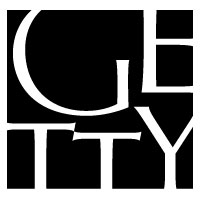

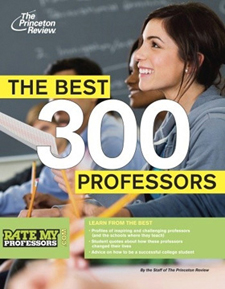

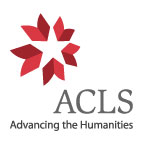

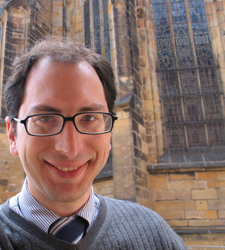 Seth Adam Hindin
Seth Adam Hindin
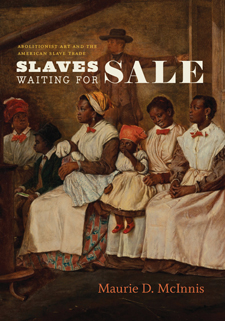

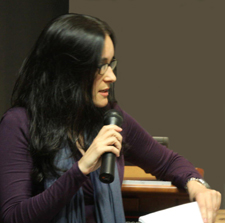 Tanya Sheehan
Tanya Sheehan
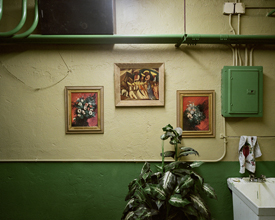 Gesche Würfel, Basement Series, digital C-type print (artwork © Gesche Würfel)
Gesche Würfel, Basement Series, digital C-type print (artwork © Gesche Würfel)